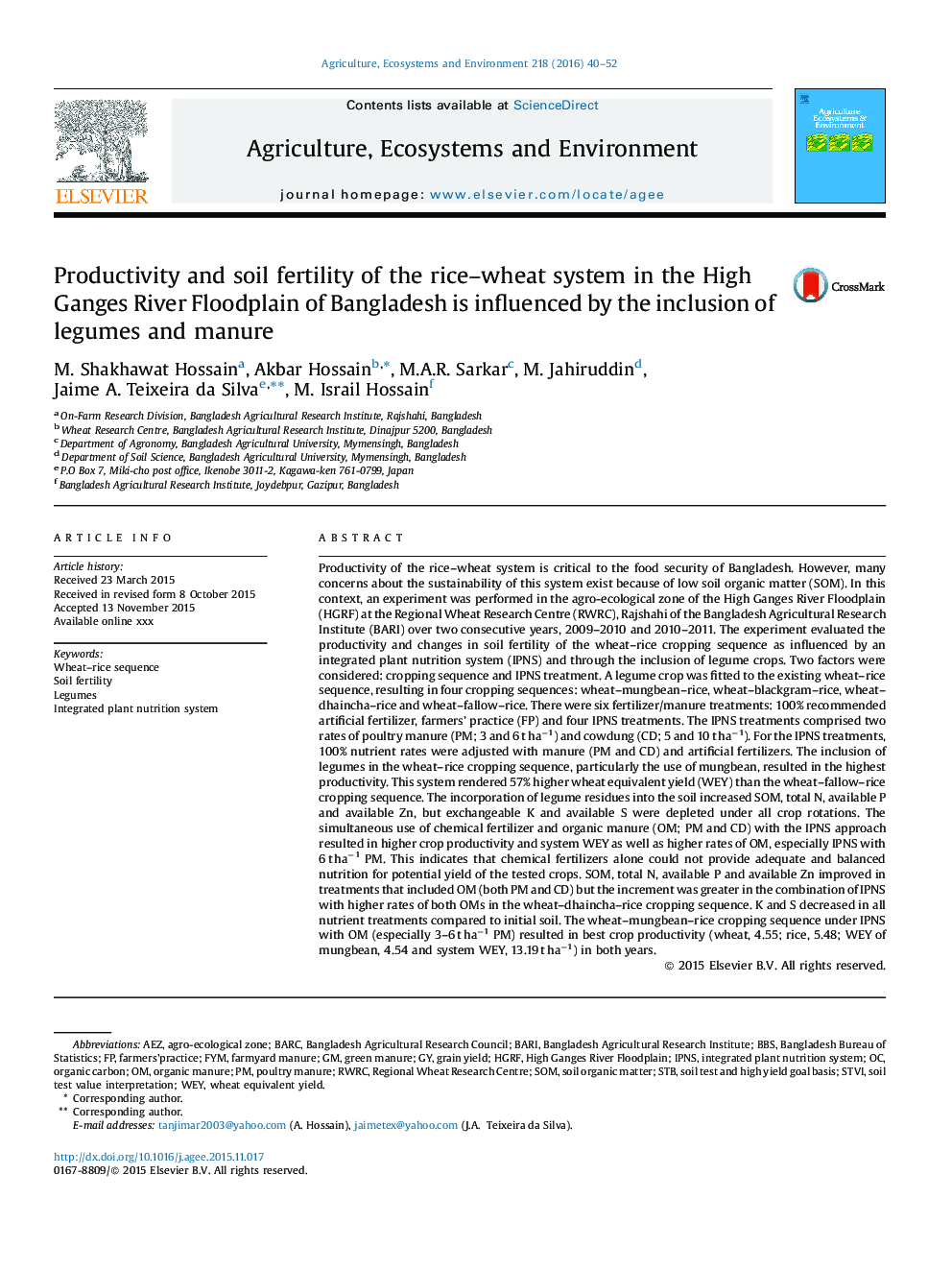| Article ID | Journal | Published Year | Pages | File Type |
|---|---|---|---|---|
| 8487540 | Agriculture, Ecosystems & Environment | 2016 | 13 Pages |
Abstract
Productivity of the rice-wheat system is critical to the food security of Bangladesh. However, many concerns about the sustainability of this system exist because of low soil organic matter (SOM). In this context, an experiment was performed in the agro-ecological zone of the High Ganges River Floodplain (HGRF) at the Regional Wheat Research Centre (RWRC), Rajshahi of the Bangladesh Agricultural Research Institute (BARI) over two consecutive years, 2009-2010 and 2010-2011. The experiment evaluated the productivity and changes in soil fertility of the wheat-rice cropping sequence as influenced by an integrated plant nutrition system (IPNS) and through the inclusion of legume crops. Two factors were considered: cropping sequence and IPNS treatment. A legume crop was fitted to the existing wheat-rice sequence, resulting in four cropping sequences: wheat-mungbean-rice, wheat-blackgram-rice, wheat-dhaincha-rice and wheat-fallow-rice. There were six fertilizer/manure treatments: 100% recommended artificial fertilizer, farmers' practice (FP) and four IPNS treatments. The IPNS treatments comprised two rates of poultry manure (PM; 3 and 6 t haâ1) and cowdung (CD; 5 and 10 t haâ1). For the IPNS treatments, 100% nutrient rates were adjusted with manure (PM and CD) and artificial fertilizers. The inclusion of legumes in the wheat-rice cropping sequence, particularly the use of mungbean, resulted in the highest productivity. This system rendered 57% higher wheat equivalent yield (WEY) than the wheat-fallow-rice cropping sequence. The incorporation of legume residues into the soil increased SOM, total N, available P and available Zn, but exchangeable K and available S were depleted under all crop rotations. The simultaneous use of chemical fertilizer and organic manure (OM; PM and CD) with the IPNS approach resulted in higher crop productivity and system WEY as well as higher rates of OM, especially IPNS with 6 t haâ1 PM. This indicates that chemical fertilizers alone could not provide adequate and balanced nutrition for potential yield of the tested crops. SOM, total N, available P and available Zn improved in treatments that included OM (both PM and CD) but the increment was greater in the combination of IPNS with higher rates of both OMs in the wheat-dhaincha-rice cropping sequence. K and S decreased in all nutrient treatments compared to initial soil. The wheat-mungbean-rice cropping sequence under IPNS with OM (especially 3-6 t haâ1 PM) resulted in best crop productivity (wheat, 4.55; rice, 5.48; WEY of mungbean, 4.54 and system WEY, 13.19 t haâ1) in both years.
Keywords
Related Topics
Life Sciences
Agricultural and Biological Sciences
Agronomy and Crop Science
Authors
M. Shakhawat Hossain, Akbar Hossain, M.A.R. Sarkar, M. Jahiruddin, Jaime A. Teixeira da Silva, M. Israil Hossain,
